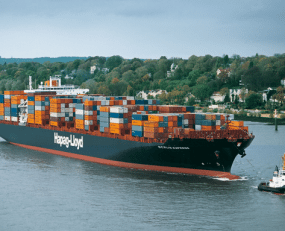
The conveyor belt of record-breaking results from shipping lines continues with Hapag Lloyd’s nine-month numbers. Revenue for the Hamburg-based shipping line was up by 70.5% year-on-year to $17.9bn, whilst EBITDA (Earnings Before Interest, Depreciation and Amortisation) was up 20% to $8.2bn. ‘Group profit’ was $6.7bn, up from $5.8bn over the same period last year.
As Hapag Lloyd admits the “the rise can primarily be attributed to a higher average freight rate of 1,818 USD/TEU” which contrasts to $1097/TEU in the first nine months of 2020, something that Hapag Lloyd ascribes the “persistently high demand for container transports with scarce capacities at the same time”. However, in the same paragraph, the company states that volumes of containers handled only increased by 3.3% year-on-year to 8.98m TEU.
The price of bunker fuel was up by $50 compared to last year, at $452/metric tonne. However other costs also had an impact, with terminal congestion resulting in an overall increase in ‘transport costs’ of 16% for the nine-month period. Rolf Habben Jansen, CEO of Hapag-Lloyd commented around the results that the “enormous pressure” on supply chains had created “additional operational burdens for carriers, ports and terminals” although Hapag Lloyd was doing “everything in our power to help with suitable offers and to do our part to resolve the situation through targeted investments and flexible capacity management”. Looking at the company’s experience, it seems that the main regions seeing congestion are the intra-Asian trade and the trans-Pacific route. Waiting times for Hapag Lloyds ships at North American ports have increased by 301%.
Looking at Hapag Lloyd’s numbers it seems that the situation will not be getting a lot better in the near future. Container volume is forecast by Hapag Lloyd to grow at a moderate 4.8% in 2022 whilst the number of ships ordered is now equivalent to a capacity of 5.4m TEU. This latter number has driven-up the ratio of ships on order to the existing fleet to 22%, yet these new ships are forecast to enter service only in 2023-2024, leaving the balance between demand and supply to favour higher freight rates for much of the next twelve months. Therefore, it is unsurprising that Hapag Lloyd “expects that earnings momentum will also remain at a high level for the rest of the year” and probably beyond.
Source: Transport Intelligence, 16 November 2021
Author: Thomas Cullen